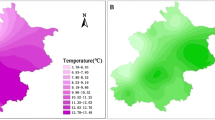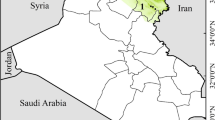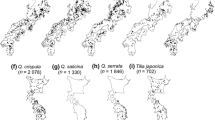Abstract
To assess the impact of Quercus acuta, a dominant species in the evergreen broad-leaved forests of Japan, and its habitat shifts as a result of climate change, we predicted the potential habitats under the current climate and two climate change scenarios using a random forest (RF). The presence/absence records of Q. acuta were extracted from the Phytosociological Relevè Data Base as response variables, and four climatic variables (warmth index, WI; minimum temperature of the coldest month, TMC; summer precipitation, PRS; and winter precipitation, PRW) were used as predictor variables. The mean decrease in the Gini criterion revealed that WI was the most influential factor followed by TMC. The RF revealed a considerable increase in potential habitats (PHs) under the climate change scenarios for 2081–2100 (RCM20, 180,141 km2; MIROC, 175,635 km2) relative to the current climate (150,542 km2). The land use variables were used for masking PH. The PH masked by land use (PHLU) was approximately half of the PH under the current conditions (74,567 km2). Under the climate change scenarios and 1 km migration options, the PHLU were not increased relative to its value under the current conditions. The distribution of Q. acuta was restricted by the northward shift in northern Honshu, but expanded as a result of the upward shift into the mountain areas of Western Japan. Habitat fragmentation reduced the ability of migration to respond to climate change in the lowland areas of Japan.







Similar content being viewed by others
References
Araújo M, Cabeza M, Thuiller W, hannah L, Williams PH (2004) Would climate change drive species out of reserves? An assessment of exiting reserve-selection methods. Glob Chang Biol 10:1618–1626
Benito GM, Sánchez de DR, Sainz OH (2008) Effects of climate change on the distribution of Iberian tree species. Appl Veg Sci 10:169–178
Bolliger J, Kienast F, Soliva R, Rutherford G (2007) Spatial sensitivity of species habitat patterns to scenarios of land use change (Switzerland). Landsc Ecol 22:773–789
Breiman L (2001) Random forest. Mach Learn 45:5–32
Breiman L, Friedman JH, Olshen RA, Stone CJ (1984) Classification and regression trees. Chapman & Hall/CRC, Boca Raton
Cohen J (1960) A coefficient of agreement for nominal scales. Educ Psychol Meas 20:37–46
Corlett R (2009) Seed dispersal distance and plant migration potential in tropical East Asia. Biotropica 41(5):592–598
Davis MB, Shaw RG (2001) Range shifts and adaptive responses to quaternary climate change. Science 292:673–679
Fielding AH, Bell JF (1997) A review of methods for the assessment of prediction errors in conservation presence/absence models. Environ Conserv 24(1):38–49
Fujiwara F (1981) Phytosociological investigation of the evergreen broad-leaved forests of Japan-1. Yokohama Natl Univ 7(1):67–133 (in Japanese with English summary)
Geographical Survey Institute (1992) User’s guide to the digital map. Japan Map Center, Tokyo (in Japanese)
Guisan A, Thuiller W (2005) Predicting species distribution: offering more than simple habitat models. Ecol Lett 8:993–1009
Hattori T, Nakanishi S (1985) On the distributional limits of the lucidophyllous forests in Japanese archipelago. Bot Mag, Tokyo 98:317–333
Hattori T, Ishida H, Kodane S, Minamiyama N (2002) The characteristics of lucidophyllous forest flora and conditions endangering them in Japan. J JILA 65(5):609–614 (in Japanese with English summary)
Heikkinen R, Luoto M, Araújo M, Virkkala R, Thuiller W, Sykes M (2006) Methods and uncertainties in bioclimatic envelope modeling under climate change. Prog Phys Geogr 6:1–27
Hickler T, Smith B, Sykes MT, Davis MB, Sugita S, Walker K (2004) Using a generalized vegetation model to simulate vegetation dynamics in northeastern USA. Ecology 85(2):519–530
Higgins SI, Lavorel S, Revilla E (2004) Estimating plant migration rates under habitat loss and fragmentation. Oikos 101:354–366
Horikawa Y (1972) Atlas of the Japanese flora 1. Gakken, Tokyo
Horikawa M, Tsuyama I, Matsui T, Kominami T, Tanaka N (2009) Predicting potential habitat of Japanese stone pine (Pinus pumila) and impact of global warming. Landsc Ecol 24:115–128
IPCC (2001a) In: Houghton JT, Ding Y, Griggs DJ, Noguer M, van der Linden PJ, Dai X, Maskell K, Johnson CA (eds) Climate change 2001: the scientific basis, Chap 2. Cambridge University Press, Cambridge
IPCC (2001b) In: MaCarthy MM, Canziani OF, Leary NA, Dokken DJ, White KS (eds) Climate change 2001: impacts, adaptation and vulnerability. Contribution of working group II to the third assessment report of the intergovernmental panel on climate change, Chap 3. Cambridge University Press, Cambridge
IPCC (2007) In: Solomon S, Qin D, Manning M, Chen Z, Marquis M, Averyt KB, Tignor M, Miller HL (eds) Climate change 2007: the physical science basis, Chap 10. Cambridge University Press, Cambridge
Iverson LR, Schwartz MW, Prasad AM (2004) Potential colonization of newly available tree-species habitat under climate change: an analysis for five eastern US species. Landsc Ecol 19:787–799
Iverson LR, Prasad AM, Matthews N, Peters M (2008) Estimating potential habitat for 134 eastern US tree species under six climate scenarios. For Ecol Manag 254:390–406
Japan Map Center (1998) Numerical map user guide, 2nd version. Japan Map Center, Japan (in Japanese)
Japan Meteorological Agency (1996) Climate normals for Japan. Japan Meteorological Agency, Tokyo (in Japanese)
Japan Meteorological Agency (2004) MRI-RCM20. Global Environment and Marine Department of Japan Meteorological Agency, Tokyo, Japan
Kanazawa Y, Nishikata S (1976) Disappearance of acorns from the floor in Quercus crispula forest. J Jpn For Sci 58:52–56
Kayama M, Etoh K, Kajimoto T (2007) Photosynthetic characteristics of evergreen oak planted on the same plantation. Kyushu J For Res 60:75–78
Kira T (1977) A climatological interpretation of Japanese vegetation zones. In: Miyawaki A, Tuxen R (eds) Vegetation science and environmental protection. Maruzen, Tokyo, Japan, pp 21–30
K-1 model developers (2004) In: Hasumi H, Emori S (eds) K-1 coupled model (MIROC) description K-1 technical report no. 1. Center for climate system research, University of Tokyo, Japan
Lenoir J, Gegout JC, Marquet PA, Ruffray P, Brisse H (2008) A significant upward shift in plant species optimum elevation during the 20th century. Science 320(5884):1768–1771
Luoto M, Toivonen T, Heikkinen R (2006) The role of land cover in bioclimatic models depends on spatial resolution. Glob Chang Biol 16(1):34–42
Matsui T, Yagihasi T, Nakaya T, Taoda H, Yoshinaga S, Daimaru H, Tanaka N (2004) Probability distributions, vulnerability and sensitivity in Fagus crenata forests following predicted climate change in Japan. J Veg Sci 15:605–614
Matsui T, Takahashi K, Tanaka N, Hijioka Y, Horikawa M, Yagihashi T, Harasawa H (2009) Evaluation of habitat sustainability and vulnerability for beech (Fagus crenata) forests under 110 hypothetical climate change scenarios in Japan. Appl Veg Sci 12:328–339
Matsushita M (1992) Lucidophyllous forests development along the pacific coast of the Japan archipelago during the Holocene. Q Res 31(5):375–387 (in Japanese with English summary)
Ministry of Environment (1999) The dataset for GIS on the natural environment, Japan (ver.2). Ministry of Environment, Tokyo, Japan
Ministry of Environment (2004) The report of the vegetation survey in the 5th national survey on the natural environment. Ministry of Environment, Tokyo, Japan
Momserud N, Leemans R (1992) Comparing global vegetation maps with the Kappa statistics. Ecol Model 62:275–293
Motta R, Nola P (2001) Growth trends and dynamics in subalpine forest stands in Varatia valley (Piedmont, Italy) and their relationships with human activities and global change. J Veg Sci 12(2):219–230
Nakao K, Matsui T, Tanaka N, Hukusima T (2009) Climatic controls of the distribution and abundance of two evergreen Quercus species in Japan. Jpn J For Environ 51(1):27–37 (in Japanese with English summary)
Ohlemuller R, Gritti E, Sykes M, Thomas C (2006) Quantifying components of risk for European woody species under climate change. Glob Chang Biol 12:1788–1799
Ohsawa M (1990) An interpretation in latitudinal patters of forest limits in south and East Asian mountains. J Ecol 78:326–339
Ohsawa M (1995) Latitude comparison of altitudinal changes in forest structure, leaf-type, and species richness in humid monsoon Asia. Vegetatio 121:3–10
Opdam P, Wascher D (2004) Climate change meets habitat fragmentation: linking landscape and biogeographical scale levels in research and conservation. Biol Conserv 117:287–297
Parmesan C, Yohe G (2003) A globally coherent fingerprint of climate change impacts across natural systems. Nature 421:37–42
Pearson RG, Dawson TE, Liu C (2004) Modeling species distributions in Britain: a hierarchical integration of climate and land-cover data. Ecography 27:285–298
Petit RJ, Hu FS, Dick CW (2008) Forest of the past: a window to future change. Science 320:1450–1452
Prasad AM, Iverson LR, Liaw A (2006) Newer classification and regression tree techniques: bagging and random forests for ecological prediction. Ecosystems 9:181–199
R Development Core Team (2008) R: a language and environment for statistical computing. R. Foundation for Statistical Computing, Vienna, Austria. ISBN 3-900051-07-0, URL http://www.R-project.org
Sakai A (1975) Freezing resistance of evergreen and deciduous broad-leaf trees in Japan with special reference to their distribution. Jpn J Ecol 25:101–111 (in Japanese)
Sánchez de Dios R, Benito GM, Sainz Ollero H (2009) Present and future extension of the Iberian submediterranean territories as determined from the distribution of marcescent oaks. Plant Ecol 204:189–205
Swets KA (1988) Measuring the accuracy of diagnostic systems. Science 240:1285–1293
Tagawa H (1973) Seitai seni. Kyoritu Shuppan. Tokyo, pp 87–92 (in Japanese)
Tanaka N (2007) PRDB (Phytosociological Relevè Data Base). Environment change impacts team, Forestry and Forest Products Research Institute. Available at http://www.ffpri.affrc.go.jp/labs/prdb/index-e.html. Accessed Aug 2009
Tanaka N, Matsui T, Simada K, Yagihashi Y, Taoda H (2005) Constructing vegetation databases useful for assessing impact of climate changes in Japan. J Agric Meteorol 60(5):433–438
Thuiller W, Araújo M, Lavorel S (2004) Do we need land-cover data to model species distributions in Europe? J Biogeogr 31:353–361
Walther GR, Gritti ES, Berger S, Hickler T, Tang Z, Sykes MT (2007) Palms tracking climate change. Glob Ecol Biogeogr 16(6):801–809
Wang CW (1961) The forest of China with a survey of grassland and desert vegetation. Maria Moors Cabot Foundation Publication No. 5. Harv Univ, Cambridge
Yokozwa M, Goto S, Hayashi Y, Seino H (2003) Mesh climate change impacts in Japan under the gradually increasing atmospheric CO2 concentration. J Agric Meteorol 59:117–130
Zweing MH, Campbell G (1993) Receiver-operating characteristic (ROC) plots: a fundamental evaluation tool in clinical medicine. Clin Chem 39:561–577
Acknowlegment
We thank T Hukusima, H Daimaru, M Higa, E Nakazono, and H Ohashi for their useful comments on an earlier version of the manuscript. This study was supported by the Global Environmental Research of Japan (S-4 and S-8) program of the Ministry of the Environment, and the fund for development of mitigation and adaptation techniques to global warming in the sectors of agriculture, forestry, and fisheries under Ministry of Agriculture, Forestry and Fisheries, Japan.
Author information
Authors and Affiliations
Corresponding author
Rights and permissions
About this article
Cite this article
Nakao, K., Matsui, T., Horikawa, M. et al. Assessing the impact of land use and climate change on the evergreen broad-leaved species of Quercus acuta in Japan. Plant Ecol 212, 229–243 (2011). https://doi.org/10.1007/s11258-010-9817-7
Received:
Accepted:
Published:
Issue Date:
DOI: https://doi.org/10.1007/s11258-010-9817-7




